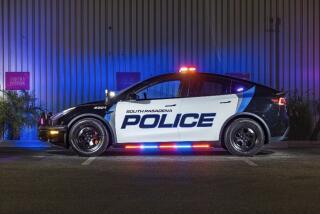High-Tech Race Driven by Old-Time Muscle Power
- Share via
Cruising on the grassy Cal State Northridge campus Sunday were not just the usual bikes, but also a collection of two- and three-wheeled contraptions--many shaped like clamshells--pedaled by humans. Many of the riders were reclining and a couple of them were lying on their stomachs.
The 23 devices, with names like Cycopath, Wild Thang, Hecho En Mexico and Miss Guided Illusion, came from universities and colleges as far up the coast as Washington state and as far down as San Diego. They came to take part in the seventh annual Human Powered Vehicle Competition sponsored by the Western region of the American Society of Mechanical Engineers.
Portland State University pedaled away from the competition with Terminator, which looked something like a regular bike enveloped in a white sheath. It finished the 44-mile course on campus paths in 118.85 minutes for a speed of about 22 m.p.h.
The Terminator also won the speed races Saturday at the Encino Velodrome, at 38.92 m.p.h. The world sprint record, set by a Watsonville man, is 65.49 m.p.h., said Jim Crouse, a member of the Los Angeles/Orange County Human Powered Vehicle Club and the International Human Powered Vehicle Assn., based in Indianapolis.
Sacramento’s American River College entry, the first two-year school to participate in the race, finished second with Newton’s Nightmare II. Cal State Chico’s Java Jet came in third.
Human powered vehicles--which include bicycles--have no “stored energy,” said Crouse, a mechanical engineer for Rocketdyne in Canoga Park. “No flywheels, no batteries, no rubber bands, or springs--just human power alone,” he said. But a regular bike is “extremely inefficient aerodynamically,” because of the bulky frontal area of the rider and the bike, he said.
“Every time I see a bike on the road with cheaters--discs on your wheels, modified handlebars, downhill bars--I think, it’s so much easier to get one of these, and you put in half the effort,” Crouse said, pointing to some of the vehicles whizzing by on the course.
He said that in 10 years, hybrid vehicles, running on human pedal power and electricity, will be on the market.
The contest helps students develop their engineering skills and offers “interesting competition with the possibility of social benefits,” said Gregg Dixon, assistant dean of the school of engineering and computer science, and faculty adviser for the Society of Mechanical Engineers’ chapter at CSUN.
At the starting line Sunday morning, the UC Davis team sealed the top covers of Accelerator III and Carbon Copy with packing tape. The covers--or “fairings”--help cut wind resistance. Nearby, two men steadied the Java Jet of Cal State Chico, while another helped Lori Graham hop over the blue body. She locked her shoes into ski-binding-type holders on the pedals, hooked onto a torso harness and tested the flow from a water bottle to a thin tube near her mouth.
In most of the vehicles, steering is more difficult than on a regular bike, partly because of the tight “fairing” and a longer distance between the wheels, said Matt Radovan, 21, a junior at UC Berkeley.
By the end of the race about two hours later, a dozen riders had been treated for minor road burns or scrapes. Many had skidded while turning corners, which were lined with bales of hay to break the impact.
Each team was required to use four different riders, including at least one woman. Changing riders, for many teams, meant catching the vehicles, ripping off the packing tape and taping in a fresh rider.
Riding is “like being in a high-performance fighter airplane,” said a breathless Doug Walters, 27, his hair soaked in sweat after pedaling several laps in Cal State Sacramento’s Bad Attitude.
Most of the designs had riders in reclining positions to help reduce air resistance. They may not have been the most comfortable or elegant-looking, but they were the pride and joy of their student creators, many of whom received course credit for their work.
Ken Boyd, 23, a Berkeley graduate who works at Ford Motor Co. in Michigan, came to see his alma mater’s improvements on the original Concept Z, which he had helped design last year.
“Berkeley is a real theoretical school,” so in projects such as this, “you learn a lot of practical, hands-on experience,” he said. ‘Otherwise, you’d never get into a machine shop. . . . You have to do more than write equations.”
The winning 40-pound Terminator was crafted by four seniors and first-year graduate students who had been working since Christmas break, said Portland State team member Jim Pileggi, 25. The vehicle--with aluminum frame, fiberglass shell and standard bike racing tires--cost $998, he said.
But unlike most of its competitors, the Terminator has a standard bike configuration rather than a reclining position, and was not covered on top. “They think their aerodynamics will make the difference. We think rider comfort and output will make the difference,” Pileggi said. The device, he added, offers more stability, visibility and control than other entries.
The team tested their creation at a Portland shopping mall parking lot at night, said senior Ron Elder. “The competition stretches your ability to come up with better solutions,” said Elder, who rides a mountain bike to school, about 27 miles a day, and wants to work in automotive design.
Students agreed that the teamwork, project management, selection of materials, designing and testing would help in their future careers in the aerospace, automotive and composite material fields.
As for the Portland winners, they plan to celebrate with a trip to Disneyland on Monday and enter the international association competition in September in Michigan.
More to Read
Sign up for Essential California
The most important California stories and recommendations in your inbox every morning.
You may occasionally receive promotional content from the Los Angeles Times.













